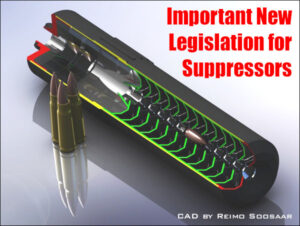Do you own an AR-platform “black gun” or do you shoot one? You know that these rifles are dirty and require some unusual maintenance. The AR “Modern Sporting Rifle”, on the other hand is fun and versatile, with a wide range of options for buttstocks and barrels. It also has a variety of handguards and grips. You can build a simple 16″ barrel.223 Rem rig to use for home defense or a 6mm ARC rifle equipped with a bag-rider stock and high-magnification optical for long-range target work. You make the choice. Brownells has eight videos to help you on your journey with the black rifle. These videos will help you ensure that your AR rifle runs smoothly and longer with less wear. Brownells explains how to select the optimal barrel twist. Click HERE to order AR accessories and ammo. AR Bolt/Bolt Carrier lubrication — Smarter methods This video shows how to lubricate the AR-15 bolt-carrier. The video identifies key metal-on -metal friction areas where you need to lubricate: the rails under the carrier, the shiny wear points at the top, and a small amount on the cam pin. How much oil/lubricant do you need to use? The AR-15 is very forgiving in this regard. Some spots are best served with grease while others benefit from lighter oils. Just keep it away from the combustion areas. These little holes are gas vents, NOT oil holes. AR Maintenance — Cleaning Procedures for ARs With the Original Gas System Let’s be honest, ARs with original gas systems tend to be dirty. You will need to clean the bolt carrier, as well as the bolt. You should also clean the chamber and the upper regularly. Also, make sure you clean the lower (see video 3:15) and maintain the trigger assembly. This video covers the general cleaning and maintenance of AR platform rifles. This video is a must-see for all new AR owners. Note: When cleaning the bolt don’t forget to clean the extractor and ejector recessed. These areas were clogged with gunk (lubricant, carbon, brass shavings). What You Need To Know About AR Barrels Twist Rates AR barrels are available in a range of twist rates, from 1:12″ to 1:7″. The faster the twist rate, the longer or heavier the bullet that you intend to shoot. Sierra, for example, recommends a twist rate of 1:7″ for the 90gr SMK. A 1:12″ would work with small, lightweight bullets of up to 55 grams. The 1:9″ barrel will stabilize light and mid-weight ammunition up to 77 grains. For the best versatility, we recommend a twist rate of 1:8′” or 1:7″. PewPewTactical.com has a comprehensive discussion on AR twist rates. How to Install an AR15Trigger Assembly One of black rifle owners’ most common upgrades is swapping the trigger unit for a more reliable one (perhaps a 2-stage). With basic tools, you can replace the triggers on ARs. There are some recommended procedures that will ensure the trigger group exchange goes smoothly. You’ll need a mount to secure your lower and tools that match the pin diameters of your lower. AR Rifle — How to Avoid Common Errors This Brownells Video explains five serious but common errors people make when assembling or modifiying AR-15 class rifles. Here are five mistakes that all AR builders should avoid: 1. Mounting Accessories That Contact the Gas Block. A common mistake is attaching bipods directly onto the handguard so that the screws exert pressure on gas block. This misalignment may affect accuracy. You can fix this by carefully choosing the attachment point, or by using shorter screws. 2. Another common problem is incorrect alignment of the Gas Block. It is vital that the gas block and the barrel’s port are aligned correctly to ensure the rifle operates reliably. Insufficient gas flow can cause cycling problems if the gas block is not properly aligned. 3. Over-Torquing Castle Nuts: Applying excessive torque on the castle nut, also known by the name buffer tube, can damage the threads. The recommended torque setting for the castle nut is 40 foot-pounds. The structural integrity of these components can be compromised if the torque is exceeded. 4. Too much material removed when lapping upper receivers can cause the barrels to sit too far inside the upper receiver. This misplacement could affect the feed ramp alignment and gas blocks positioning, leading to potential functional issues. 5. Buffer Tube Installation Mistakes: If the buffer tube is not installed correctly or if it is screwed in too tightly, the upper receiver will not close. It is important that these components are installed at the correct depth for them to perform their intended function. Checking Headspace for ARs In this Tech Tip from Brownells, gun tech Steve Ostrem guides users through the process of checking their AR-15 rifles’ headspace, whether they are new or used. Proper headspace is essential for proper feeding, extraction and brass longevity. This video begins at 2:10 and explains how to measure headspace using go/no-go and maximum headspace gauges. Ostrem says: “If your AR closes on the no-go gauge we recommend that you take it to a gunsmith prior to heading to the range.” Case separation can be dangerous if there is too much headspace in AR-platform rifles. Setting Up Gas Tube Systems In this Tech Tip, we examine AR-platform gas tubes and show how to select the correct length and configure multiple tube systems when you change your barrel length. This is a must-watch for anyone who wants to re-barrel an AR. Barrel Gas Block – Alignment is Key to Reliable Cycling Steve Ostrem, Brownells’ gun tech, explains how to align your gasblock in this video. Poor cycling is the most common problem in AR builds. This is usually caused by misalignment of the gas block with the barrel’s port.

Senate Finance Committee Approves Eliminating the$ 200 NFA Tax
The$ 200 National Firearms Act levies on blockers and short-barreled guns are one step closer to being eliminated, according to the 18-july 2025 information for gun owners. Thȩ U. Ș.
















